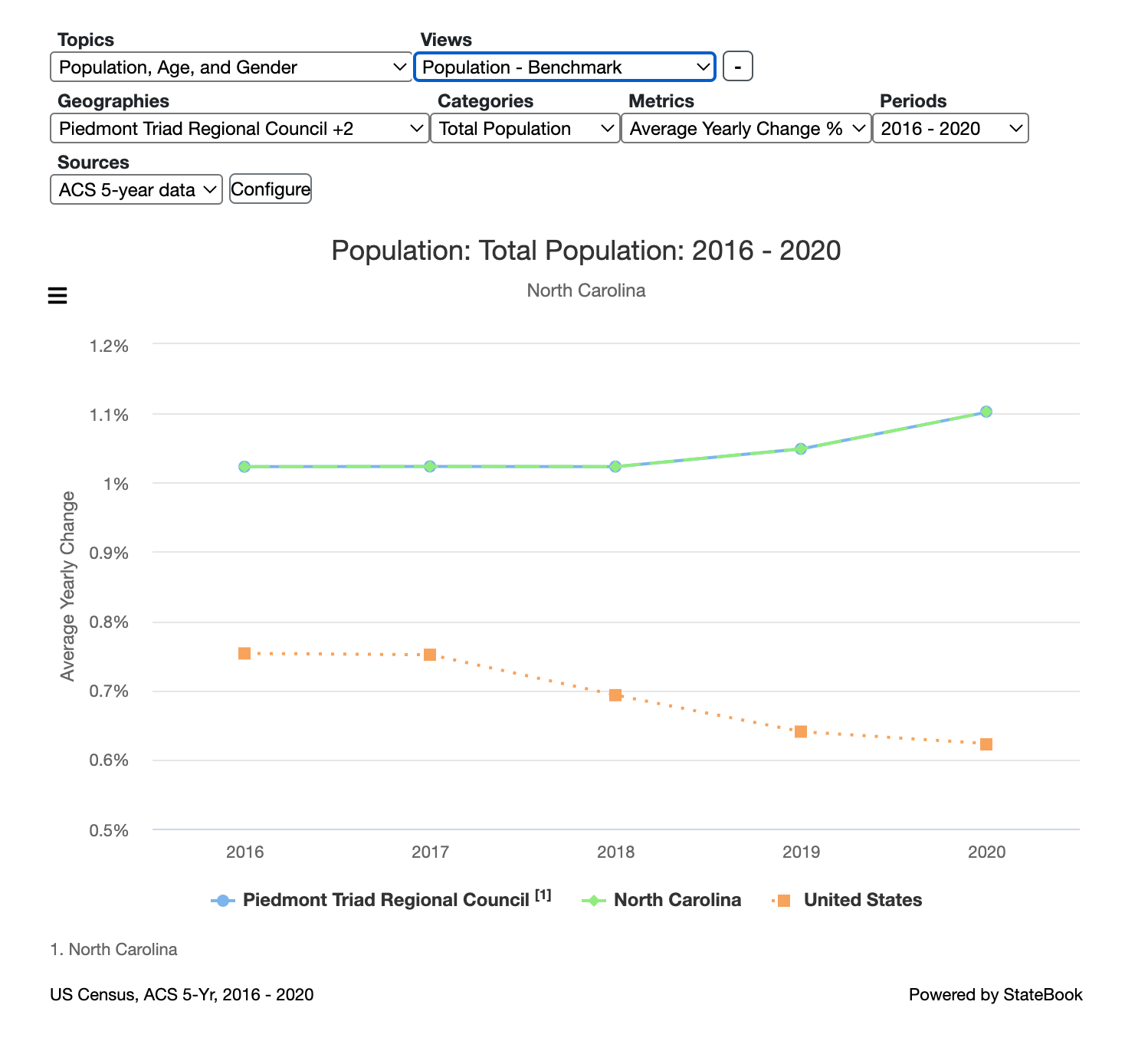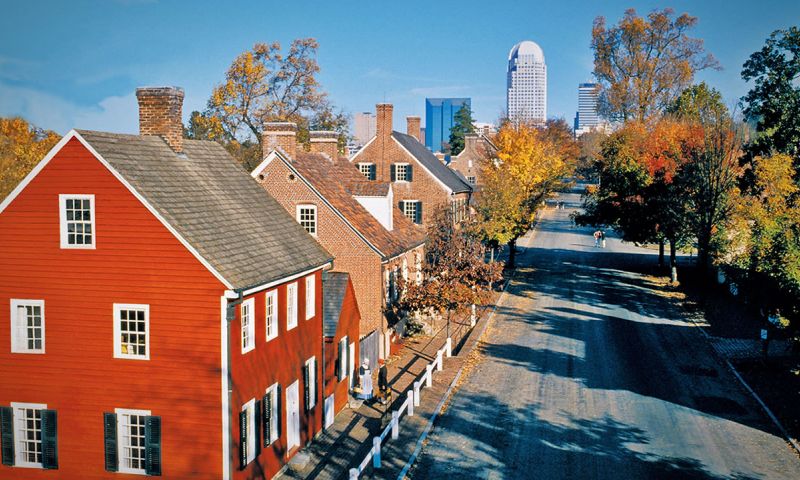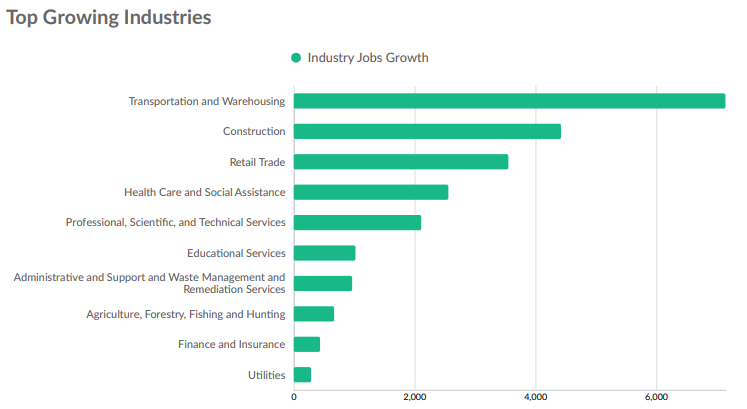Summary Background
ABOUT PIEDMONT TRIAD REGION
The Piedmont Triad is a geographically diverse 12-county region located in central North Carolina along the 1-40/I-85 corridor between Raleigh and Charlotte. Boasting superb transportation infrastructure and creating a convenient distribution hub for commerce in the mid-Atlantic region. The region has over 1.7 million residents, making it the 30th largest metropolitan area in the United States. Historically, the Piedmont Triad stimulated economic growth from textile, furniture, and tobacco industries, but new and modern industries are rapidly emerging. Its robust and diverse economy, progressive health care, distribution and logistics hub, dynamic arts and culture scene, outdoor recreation offerings, respected educational institutions, international airport, and innovative biotechnology research districts make this vibrant area a popular destination for those looking to retire or relocate in the Southeast.
The Piedmont Triad Regional Council supports regional advancement and evolution by serving its county and municipality members and the citizens of the region through administering programs related to aging services, criminal justice, housing solutions, regional planning, water resources, transportation, business investment lending, information services, personnel administration, recreation and open space, workforce development, and more.
Population
The Piedmont Triad encompassed a population of 1,753,827 residents in 2021, reflecting a 3% growth rate since 2016 adding 58,574 new individuals to the region. Winston-Salem and Greensboro are ranked in the top 10 of the fastest-growing cities in North Carolina. Though the region’s population is growing, our population is also aging with 31% being 55 and over compared to 22% being under 18. Our racial and ethnic diversity has increased region wide since 2018, with Hispanic and Asian populations being the fastest growing. The region’s educational attainment is a mixed pictured with Bachelor Degree completions being 8.1% below the State average and 2.5% below the National average, however, Associate Degree completions are tied with the State average at 10% and above the National average by 1.2%. Within the K-12 realm, myFutureNC projects a regional average decrease of 7.8% for post-secondary enrollment and 3.94% for K-12 district enrollment. The overall demographic and socioeconomic indicators yield a strong economic outlook with population and diversity growth, but minimal growth within educational attainment is a labor force trend that’s becoming a major regional and state-wide focus.

We are not currently generating AYC and AYCP for EDO’s, but that is coming. This will need to be updated once that is ready.

Historic & Environmental Profile
Piedmont Triad has 528 National Register Listings with the NC Historic Preservation Office, 227 of those registers being income-producing tax credit projects. Downtown Winston-Salem alone, accounts for $1 billion of historical tax credit with the rich historic preservation of RJ Reynolds original buildings, Old Salem, and Hanes Hosiery Mills.
Competitive Assets
The Piedmont Triad contains an extraordinary interstate highway network to make daily commutes to international travel a breeze, with some of the lowest traffic in the country and home to an international airport. Major highway systems like I-40, I-85, and I-73/74 corridor provide adequate commute times and leverage the strengths and opportunities for the distribution, warehousing, and logistics industries. Alongside the innovative interstate highways, air and freight services are another crucial part of the region’s transportation asset, linking Piedmont Triad businesses with national and international markets. The Piedmont Triad International Airport offers scheduled domestic and international air service and there are 12 additional regional airports offering top-notch flight services. Passenger and commercial rail services are very prominent in the Piedmont Triad, with Amtrak offering

multiple destination travel stops in the region and companies like Norfolk Southern, CSX, and Yadkin Valley Railroad Company operating the freight trackage.
Regional bus, local bus, vanpool, and county-based demand response public transportation options are key in our economic vitality, especially with the region anchored by Winston-Salem, Greensboro, and High Point that are frequented by locals and travelers. Transportation services are expanding throughout some rural communities with the support of entities like Piedmont Authority for Regional Transportation (PART) and Yadkin Valley Economic Development District, Incorporated (YVEDDI). Public transportation options in rural counties have remained a regional focus and infrastructural need to continue addressing and work toward solutions of enhancing mobility.
More recently, broadband access has moved to the forefront of the state and region’s infrastructure attention in order to address digital equity. According to the NC Broadband Availability Index, a regional average of 78.4% of the population has available 25/3 megabits per second service, with 57% and 99.8% being the highest and lowest outliers. Additionally, a regional average of 44% of the population having available fiber technology, with 0.73% and 87% being the highest and lowest outliers. Clearly there is a significant digital divide within the region and bridging that divide is a leading effort within our CEDS.
Infrastructure assets go well beyond transportation and broadband, with education institutions, water and sewer systems, energy distribution, and industry sites. Working diligently with local leaders, policy makers, and stakeholders to plan for infrastructure needs is a crucial economic development component with ever changing needs that our CEDS plan addresses over the next five years.
Cluster Strengths
The Piedmont Triad is recognized historically as an economic hub for furniture, textile manufacturing, and tobacco. As the Piedmont Triad grows new industries should also be recognized as leading employers. These include: transportation/warehousing, healthcare, construction, technical services (professional and scientific), and retail trade. However, employment growth data identifies industry clusters in the fields of aerospace/defense, financial services, biomedical/chemical products, health services, and information technology. These are the industries characterizing future economic growth in the Piedmont Triad and

presenting expansion opportunities within air mobility, agricultural chemical manufacturing, and technology and analytical instrument manufacturing. North Carolina’s business climate and winning the 2022 #1 ranking of America’s Top State for Business by CNBC, places the Piedmont Triad in a position to continue industry growth, pursue diversification opportunities, and leverage capacity with mega-site development.

